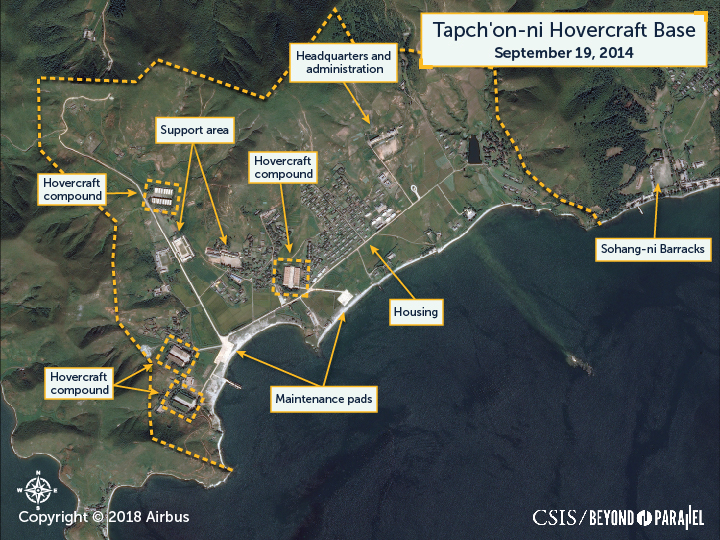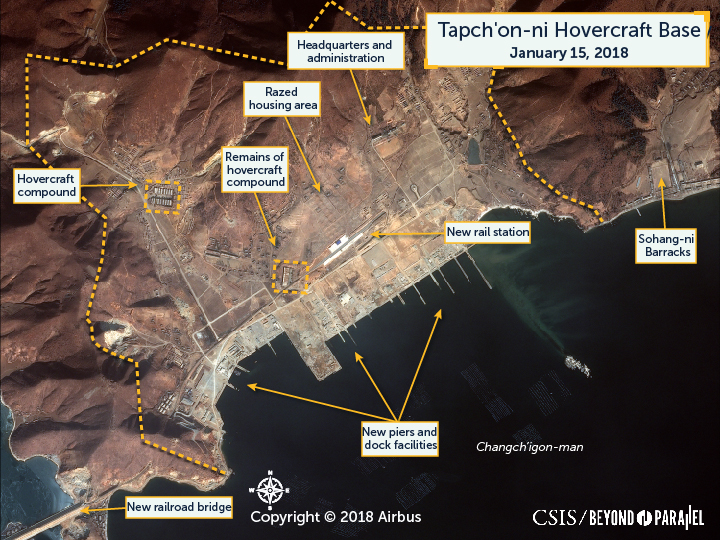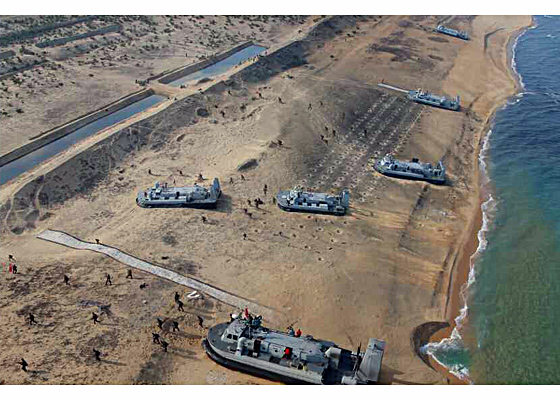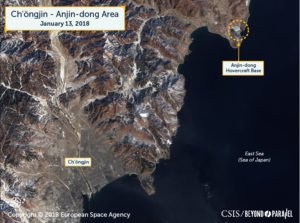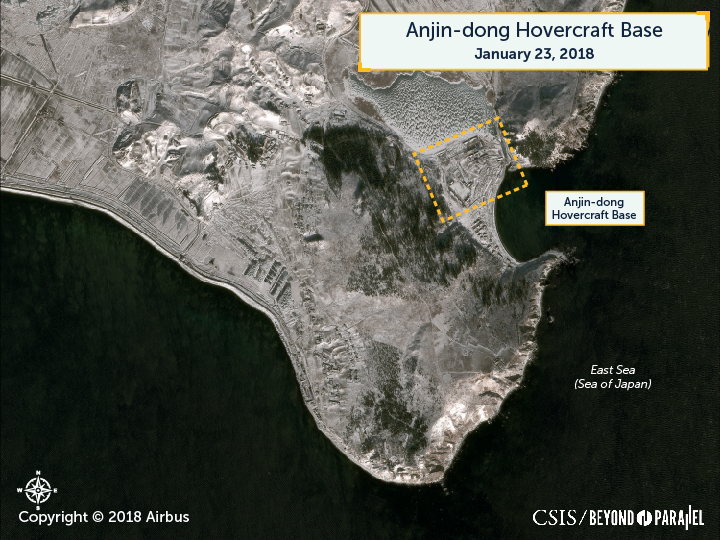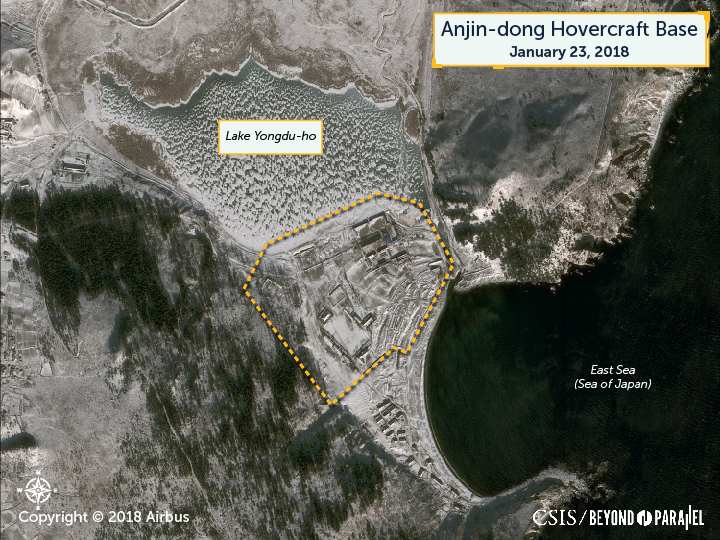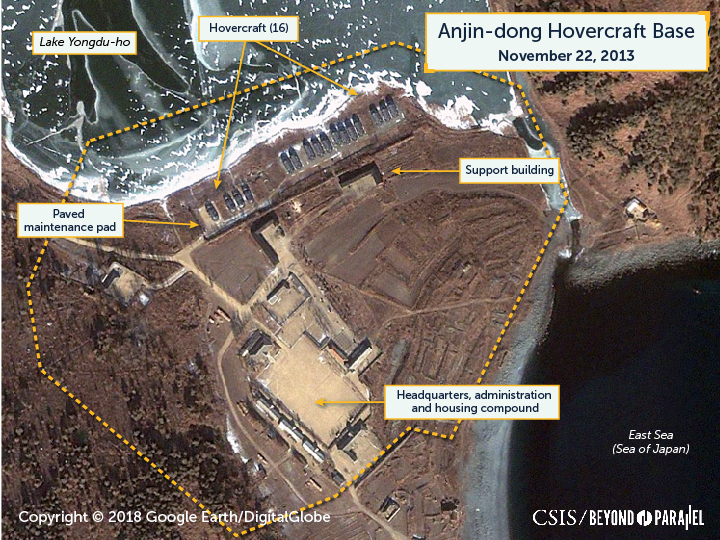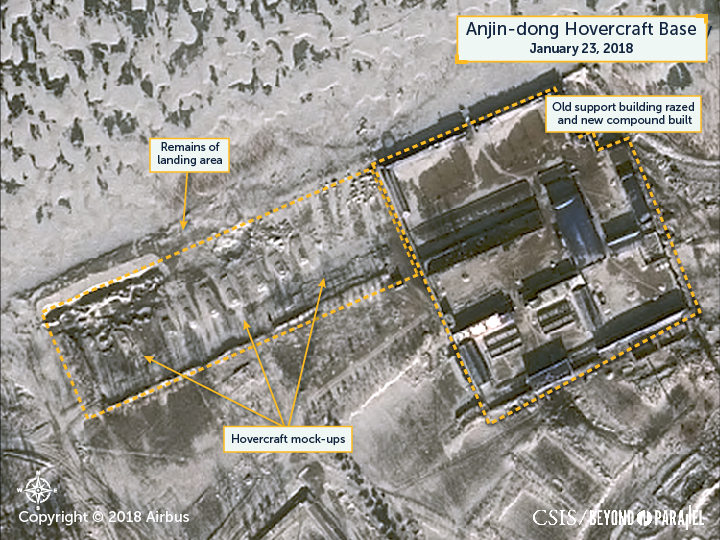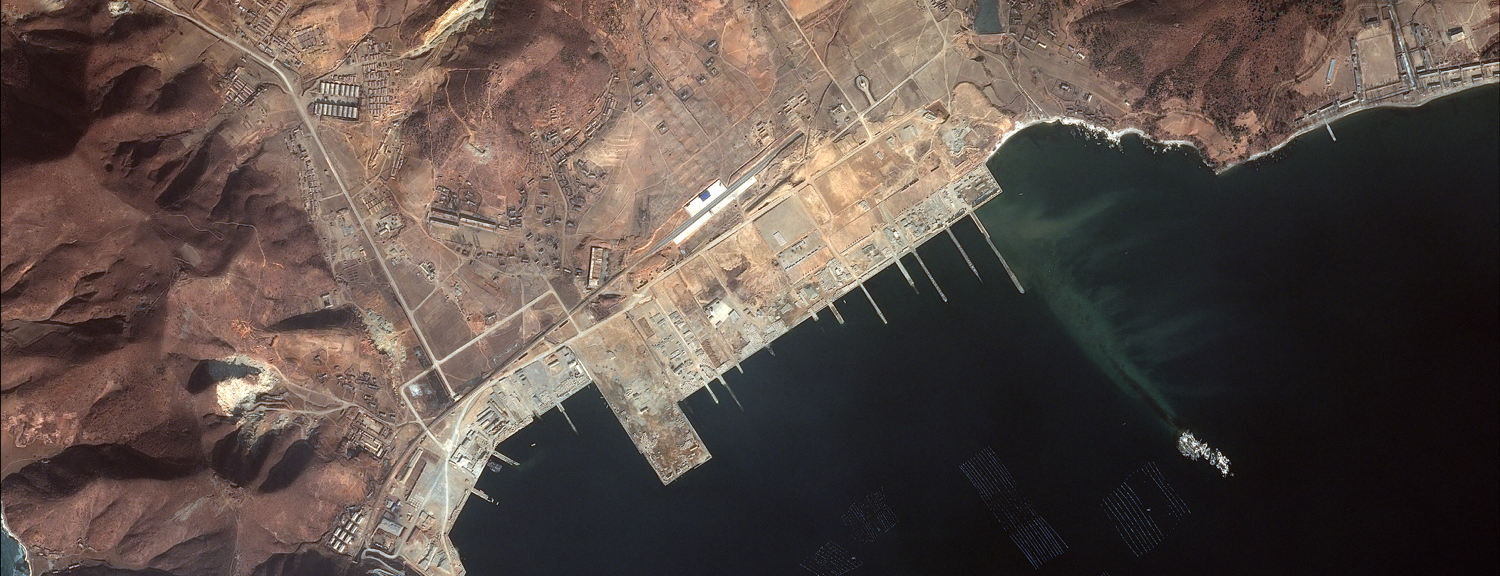
North Korean Special Operations Forces: Hovercraft Bases (Part III)
While the world is focused upon the threat posed by North Korea’s ballistic missiles and weapons of mass destruction it is important to remember that these are by no means the limits of it capabilities to threaten other countries in the region. Key among the North’s other military capabilities are its special operations forces (SOF). Embedded within North Korea’s special operations forces are two unique navy “sniper” brigades that are subordinate to the Korean People’s Navy (KPN). These sniper brigades are deployed in the East Sea Fleet and the West Sea Fleet and are tasked with reconnaissance, sabotage, subversion, and infiltration missions. Hovercraft units that operate as part of these brigades have been trained to carry out a more specialized task—amphibious assault landings and amphibious infiltration missions. Two previous Beyond Parallel reports analyzed the capabilities of hovercraft units operating in the West Sea Fleet, this report focuses exclusively on East Sea Fleet capabilities.
Key Takeaways
- Previous reports found that due to the restructuring and modernization of North Korean hovercraft bases, special units that support the offensive operations of KPN sniper brigades in both the West Sea and East Sea have evolved and become more threatening over time.
- In the East Sea, hovercraft units appear to be subordinate to a single amphibious assault command consisting of a headquarters, support elements, a number of landing craft squadrons, and four hovercraft squadrons.1
- Two hovercraft bases were maintained by the East Sea Fleet up until early 2015—one primary base at Tapch’on-ni and a satellite training base at Anjin-dong.
- Consistent with the West Sea Fleet, each hovercraft squadron in the East Sea Fleet is also equipped with 16-18 hovercraft.
- If all hovercraft from the Tapch’on-ni hovercraft base were deployed carrying the maximum number of troops, such an attack would have the potential to land approximately 2,700 special operations troops on South Korean territory within two to six hours.
- However, in contrast to the West Sea Fleet, the restructuring and modernization of hovercraft bases in the East Sea Fleet has not been as comprehensive or accelerated. Since 2015 the bases at Tapch’on-ni (답촌리) and Anjin-dong have been in a state of flux and it is unclear how basing will be organized in the upcoming years.
Tapch’on-ni
Since the introduction of hovercraft into the KPN the primary hovercraft base on the east coast has been located approximately 147 km northeast of Pyongyang, at Tapch’on-ni (Tapch’ol-li, 39.332046° 127.423312°) on the Songjŏn-bando (Songjŏn Peninsula) in Wonsan Bay.
Here, during the 1980s, North Korea established a base that would encompass approximately 3.11 km2 (769 acres) and eventually house four hovercraft squadrons, maintenance and support facilities, headquarters and administration facilities and housing.
North Korean media reports suggest that the cover designation of the KPN hovercraft unit based here is “KPN Unit 291.”2 Immediately to the east of the base are the Sohang-ni Barracks, however, it is unclear if these barracks are for hovercraft personnel, navy sniper brigade troops or some other organization.
The hovercraft themselves were housed within four squadron-sized storage compounds. Each compound was surrounded on four sides by a high earthen revetment with an entrance cut in one aide, measured approximately 90-meters-by-65-meters and contains two parallel rectangular hovercraft sheds.
Each of these sheds measured approximately 86-meters-by-22-meters and contained nine hovercraft bays that were open to the front and rear, and was large enough to accommodate a KONG BANG II/III or other class of hovercraft in KPN service. One of the sheds had a small attached administration or support building.
Taken together, these four hovercraft compounds could shelter a total of 72 hovercraft. The shed buildings are primarily for environmental protection and provide little, or no, protection from attack. All four storage compounds were connected by a taxiway that led down to two launching/maintenance pads (65-meters-by-50-meters and 125-meters-by-50-meters) located along the shore.
During 2007-2010 the northernmost hovercraft compound was razed and replaced by a hovercraft shelter facility with 16 shelters arranged in two rows of eight—reducing the total storage capacity of the base down from 72 to 70 hovercraft.
As with the shelters at Sasŭlp’o they measure approximately 10-meters-by-24-meters, are constructed of reinforced concrete walls and arched roofs, are open to the front and rear and are large enough to accommodate any class of hovercraft in KPN service.
It is unclear why the other three hovercraft storage facilities were not also converted to shelters, however, it may have been related to a major navy revitalization and construction project that began during early 2015 and witnessed a complete reconstruction of the October 3 Dockyard (reportedly under KPN Unit 597) at the Munch’ŏn Navy Base. The same project also resulted in the construction of a rail bridge from that base across a small bay to Tapch’on-ni, the razing of a majority of the Tapch’on-ni hovercraft base including the three original hovercraft shed compounds, support area buildings, housing area and construction of a new rail station, extensive dock areas and piers, and a new housing area near the remaining hovercraft shelter compound.3
To facilitate this project all the hovercraft at the Tapch’on-ni base were transferred, during early-2015, to outlying four naval facilities around the Songjŏn-bando,
• Chibugumi-ri
• Chŏdo-ri (K’ŭndol-sŏm)
• Paegot
• Panjawa-ri (Chungumo-ri)
Satellite imagery from January 2018 shows a total of 62 hovercraft distributed among naval facilities around the Songjŏn-bando, rather than the potential storage of 70 at the facility prior to the current reconstruction project. It would appear that this number also includes the hovercraft that were formerly at the Anjin-dong hovercraft base. Where the potentially missing five hovercraft are—if they exist—is unknown, however, overhaul or maintenance at one of the east coast shipyards could be an explanation.
The satellite imagery from January 2018 also shows that while the Munch’ŏn Navy Base revitalization project was completed by the end of 2015, the extensive dock areas and piers at Tapch’on-ni remain to be completed.
Chibugumi-ri
Chodo-ri (K’undol-som)
Paegot
Panjawa-ri
There are a number of strategically and historically important locations along the ROK’s east coast that are likely sites for KPN amphibious landing operations during a future conflict including, Kangnŭng (Gangneung), P’ohang (P’ohang-dong), Sokch’o and Ulchin.4
Under ideal conditions the distances from Tapch’on-ni to these potential landing sites are approximately,5
If all hovercraft were carrying their maximum number of troops such an attack has the potential to land approximately 2,700 troops in an initial assault wave.6
Training for these amphibious landings is conducted every year with regular military exercises. The annual training cycle for the East Sea Fleet hovercraft units is the same as it is for the West Sea Fleet units. Training activity is heaviest from Spring through Fall and consists of open water voyages and landing exercises primarily along the beaches and shorelines from Wonsan north to Hungnam (e.g., along the Hodo-pando, etc.).
Image: Landing Exercises Published in Rodong Sinmun on March 20, 2016.
Additionally, there is likely some unit rotation through the Anjin-dong hovercraft base. In recent years there has typically been one major joint landing exercise each year that is sometimes conducted during winter.
Image: Landing Exercises Published in Rodong Sinmun on March 20, 2016.
Such exercises are conducted with ground force land units, Air Force units—including paratroop air drops and airstrikes, and Navy vessels and submarines. They are designed to simulate wartime landings on South Korean beaches and in strategic rear areas and have included the participation of larger landing craft for infantry, tanks and artillery units. A key component of these exercises is to train regular KPA and paramilitary units in anti-landing operations.
Anjin-dong
Located approximately 475 km northeast of Pyongyang in the North’s strategic rear and only 20 km northeast of the port city of Ch’ŏngjin is the Anjin-dong hovercraft base (41.9124° 129.9524°). It is unclear when the base was first established, however, satellite imagery indicates that it was sometime prior to 2005.
The Anjin-dong hovercraft base is different from all other hovercraft bases so far identified in that it: has no hovercraft sheds or shelters; is located on an inland lake; and is located deep in the North’s strategic rear—390 km from the Demilitarized Zone. These characteristics strongly suggest that this is a satellite training base through which hovercraft squadrons from the Tapch’on-ni base are rotated.
The base is located along the southern shore of Lake Yongdu-ho—a small inland lake—that is connected to the East Sea by a short shallow river.
It originally encompassed approximately .11 km2(27 acres) and consisted of a small headquarters, administration and housing compound, several small support buildings, a 23-meter-by-18-meter paved maintenance pad and a 230-meter-by-40-meter landing area large enough to support 16 hovercraft.
From 2005 through early-2012 13-17 hovercraft were regularly based here and it was not unusual to see hovercraft recently built or refurbished at the Hambuk Shipyard in Ch’ŏngjin to temporarily be based here. During late-2012, however, the hovercraft based at Anjin-dong disappeared—presumably being redeployed to the main Tapch’on-ni hovercraft base—and haven’t been observed here again. The hovercraft were replaced by a what appears to be a collection of rudimentary hovercraft training mock-ups.7
Then, during 2017, the lone support building was razed and replaced by a walled compound with a number of buildings and greenhouses. The wall encompassing this new compound extends to the shore of the lake including a portion of the former landing area.
As of January 2018, the remains of eight hovercraft training mock-ups are still present. It is unclear whether the KPN plans to use the facility for training in the future.
References
- As noted in the previous two installments, there is considerable confusion in the open source regarding the organization of the parent unit controlling the hovercraft so the information presented here should be viewed with caution. ↩
- Bermudez Jr., Joseph S. And Melvin, Curtis. “KPA Navy Upgrades in the East Sea,” 38 North, September 1, 2016, http://www.38north.org/2016/09/munchon090116/. ↩
- Ibid. ↩
- During the Korean Conflict the KPA’s 766th Independent Regiment (the predecessor of today’s navy sniper brigades) conducted small amphibious landings at these locations in an effort to cutoff ROK Army units deployed along the east coast and to secure critical mountain passes within the T’aebaek-sanmaek. Later, during the 1960s North Korean guerrilla teams from the 124th Army Unit conducted landings at some of these same locations in an effort to ferment civil unrest and guerrilla warfare against the ROK Government. Bermudez, Joseph S., Jr. Korean People’s Army: 766th Independent Unit, 1949-1950, paper prepared for the United Nations Command, Special Operations Forces in Korea, Seoul, Korea, 10-14 September 2007; and Bermudez, Joseph S., Jr. North Korean Special Forces – Second Edition, Annapolis: U.S. Naval Institute Press, November 1997, pp. 34-39, 80-81 and 85-88. ↩
- These estimates are the worst case and assume 100 percent serviceability and no losses during the voyage to a landing—both are extremely unlikely to be achieved during wartime conditions. ↩
- Ibid. ↩
- It is unlikely that these are intended as decoys due to their crude construction. ↩


